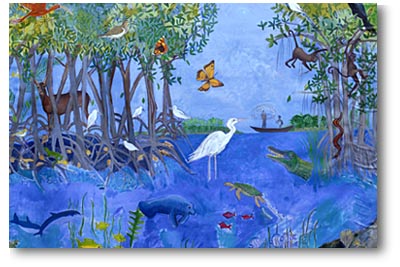|
Wetlands
are "the areas
of marsh, fen, peatland or water, whether natural or artificial, permanent
or temporary, with water that is static or flowing, fresh, brackish or
salt, including areas of marine water the depth of which at low tide does
not exceed six metres", a definition according to the Ramsar
Wetlands Convention.
In
Hong Kong, the most well-know wetland is Mai Po Marshes. Together
with the Inner Deep Bay, they were designated as the Wetlands of
International Importance Especially as Waterfowl Habitat" in
September 1995. At the estuarine (river mouth) wetlands,
characterized by the daily tidal change and the intermediate salinity
between salt and fresh water, mangroves are the unique flora commonly
found along the shores of Mai Po Marshes and Inner Deep Bay.
What
are Mangroves?
Mangroves
are the unique inter-tidal wetland ecosystems found in the intertidal zone
of sheltered tropical and subtropical shores, receiving inputs from
regular tidal flushing and from freshwater streams and rivers.
With the habitats characterized by high temperature, fluctuating salinity,
alternating aerobic and anaerobic conditions, periodic wet and dry
environments, and an unstable and shifting substratum, mangrove
communities are made up of the taxonomically diverse, salt-tolerant
tree and other plant species. They have specially adapted aerial and salt-filtering roots and
salt-excreting leaves that enable them to occupy the saline wetlands where
other plant life cannot survive.
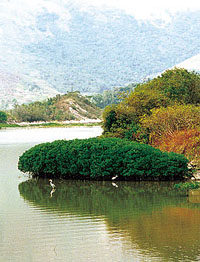 |
Mangroves
- Living at the edge of the sea
(Photos
source: AFCD's website) |
 |
|
|
¡@
Environmental
and Ecological Importance
of Mangroves
(1)
Protect the shorelines from erosion due to currents, waves, wind and
storm;
(2)
Maintain the stability and ecological balance of coastal and marine
ecosystems;
(3)
Trap and stabilize sediments, and expand shore area;
(4)
Retain nutrients, e.g. nitrogen, phosphorus, and substances such as heavy
metals from wastewater, thereby serving as a natural water and wastewater
treatment plant;
(5)
Provide diverse habitats, breeding sites and feeding grounds for a
mirgratory birds and a large variety of coastal species such as juveniles
fishes, crabs, shrimps, and mollusks, and thus maintain the biodiversity;
(6)
Supply food, e.g. the detritus containing mainly of fallen leaves and
branches, to feed the marine environment of immense varieties of sea life,
and hence supporting fisheries and aqua-culture.
¡@
Distribution
in Hong Kong
Other
than Mai Po Marshes and Inner Deep Bay, mangroves are widely
distributed along the coasts in Hong Kong in 6 districts: Deep
Bay, Sai
Kung, Northeast New Territories, Tolo Harbour, Lantau Island and
Hong Kong Island, covering a total area of about 290 ha (See the distribution
map).
| (1)
Deep Bay |
6
mangroves stands, the largest of which is in Mai Po Nature Reserve
with an area of 115 ha |
| (2)
Sai Kung |
19
mangrove stands, each of which is relatively smaller when compared
to that in Deep Bay |
| (3)
Northeast New Territories |
5
mangrove stands, most of which are remote with limited access |
| (4)
Tolo Harbour |
3
mangrove stands, many of which have been damaged due to reclamation,
construction of highways and housing estates |
| (5)
Lantau Island |
10
small stands, scattering from east to west and from north to south,
some of which are facing strong pressure from infrastructural
development of the island |
| (6)
Hong Kong Isalnd - |
Located
at Tai Tam, it is the only mangrove stand left on Hong Kong
Island |
¡@
Mangroves
Species in Hong Kong
8
common mangrove species in Hong Kong and their physiological features for
adapting the estuarine habitats of anaerobic conditions, unstable
substratum, high salinity, establishment problem, and desciation.
|
Acanthus
ilicifolius L. (¦Ñ¹«°Ç)
(Spiny
Bears Breech)

Features:
Low, viny, woody herb, with height of 1 to 2 m. Spiny margin
leaves (entire margin when young) with salt on the surface. Spike-patterned flowers Adaptations:
Salt
glands for salt
secretion
|
Aegiceras
corniculatum (®äªá¾ð)

Features:
Low evergreen tree or shrub with height of 1.5 to 4 m. Leaves
are alternate, spirally arranged, simple, entire and leathery, and
often notched at the tip. Flower of white, small, fragrant,
and perfect are organized in terminal (sometimes axillary) umbels on
reddish stalks.
Adaptations:
Knees of root above the substrate surface; Prop roots
arising from trunk and lower branches to broaden the base and
provide stability; Salt glands for salt secretion; Viviparous
reproduction with seed germinating inside the fruit without
resting stage.
¡@ |
|
Avicennia
marina (¥Õ°©Ä[)
Black
Mangrove

Features:
Pioneer species, with size varying from a small shrub of 0.5 m to a
tree of up to 4 m. Leaves are bronze green of 3 to 10 cm long
and 1 to 5 cm wide, being simple and opposite, broadly elliptic to
ovate, often rounded at the apex. Cyme-patterned flowers. Adaptations:
Pneumatophores as erected aerial roots arising from Cable
roots can facilitate exchange of gases between the submerged
roots and the atmosphere; Salt glands for salt secretion; White
tomentum at lower leaf surface for reflecting bright light
and lowering plant temperature, and hence reducing water
loss.
¡@
|
Bruguiera
gymnorrhiza (¤ìÆV)
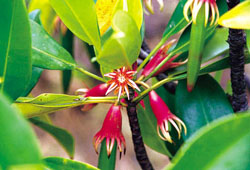
Features: Trees
grow to 6 m or more. Leaves are large, smooth, thick and
leathery, glossy green above but often pale green or reddish
beneath. Flowers are red, solitary, up to 3.5 cm long, pedicel
naked; and fruits are green to purple-tinted color, up to 15
cm. Adaptations:
Knees of root against the anaerobic conditions; Lenticels
on bark for gaseous exchange; Buttress roots forming a
flattened blade-like supporting structures; Storage of salt and
abscission against the high salinity; Viviparous
reproduction.
¡@ |
|
Excoecaria
agallocha (®üº£)
(Milky
Mangrove)
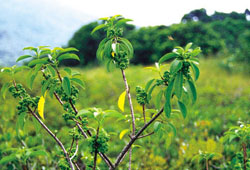
Features: A
dioecious tree of up to 10 m high with abundant white latex. The bark is grey and becomes fissured; lenticels are prominent on
younger twigs. Leaves are green when young and turns red and
yellow tinted when mature. They are spirally arranged, and
sometimes clustered towards the ends of erect shoots. Raceme-patterned flowers.
Adaptations: Sunken
stomata, epidermal hairs and scales, thick waxy cuticle in leaf
surface to reduce evaporation and water loss.
|
Heritieria
littoralis (»È¸¾ð)
(Looking-glass
tree)
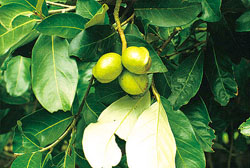
Features: A
substantial evergreen monoecious tree growing up to 20 m tall with a
large buttress root system extending horizontally of up to 60 cm in
diameter. It is a species of the back mangroves and may occupy
the forest fringe or rocky shore. Leave sizes are variable but
large (10 - 20 cm long), stiff leathery, smooth and dark green on
the upper surface but silvery white beneath due to numerous
overlapping tiny scales. Brownish red to pinkish purple
flowers are organized in loose panicles in axial position, being
small of 3 - 4 mm in diameter.
Adaptation: Buttress
roots as a form to prop root to produce flattened blade-like
supporting structures; Large, woody fruits containing one to
several seeds, which have spongy outer layers that make them
extra buoyancy.
|
|
Kandelia
candel (¬îX¡A¤ôµ§¥J)

Features: The
most dominant species that can be found everywhere in all mangrove
stands in HK, occurring at the back of the mangrove communities or
along the banks of estuarine rivers and creeks or on the banks of
tidal rivers further inland. Leaves are green, simple,
opposite of 6 - 13 cm long by 2.5 - 6 cm wide. They are
oblong-elliptic to narrowly elliptic-lanceolate with a rounded
apex. Flowers are white colored inflorescence, axillary,
bifurcating with 4 or more flowers.
Adaptations:
Knees of root that bend up like an arch and grow above the
substrate surface and are also rich in aerenchyma tissues which
fcilitate the transfer of air; Prop roots are the branched,
looping aerial roots that arise from the trunk and lower branches
for broadening the base and providing stability; Viviparous
reproduction with seeds germinating inside the dropper fruit
without resting stage, which allows rapid growth and establishment
of young plants when they are finally detached from the plant and
come into contact with the substrate.
|
Lumnitzera
racemosa (ÆV§õ)
(Lumnitzera)

Features:
An evergreen hermaphroditic tree growing up to 6 m high, appearing
as a much-branched shrub. Adaptations:
Development of pneumatophores as looping lateral roots to
facilitate exchange of air between the submerged roots and the
atmosphere; Storage of excessive salt in vacuoles or older
leaves which will then be shed to reduce the salt content inside the
plants and abscission.
¡@ |
 World Wetlands Day (2/2),
set
for 2nd February of each year, in recognition of the signing of the
Convention on Wetlands on 2 February 1971, in the Iranian city of Ramsar,
was celebrated for the first time in 1997. The purpose of World
Wetlands Day is to provide an opportunity for government and
citizens' groups to undertake actions aimed at raising public awareness of
wetland values and benefits in general and the Ramsar Convention in
particular.
World Wetlands Day (2/2),
set
for 2nd February of each year, in recognition of the signing of the
Convention on Wetlands on 2 February 1971, in the Iranian city of Ramsar,
was celebrated for the first time in 1997. The purpose of World
Wetlands Day is to provide an opportunity for government and
citizens' groups to undertake actions aimed at raising public awareness of
wetland values and benefits in general and the Ramsar Convention in
particular.
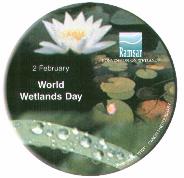

 |
